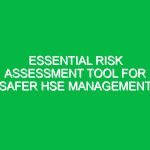Welcome and Purpose
Good morning, team! Today, we are gathered for this toolbox talk to discuss an essential topic that plays a crucial role in our Health, Safety, and Environment (HSE) practices: Seal Checks. These checks are vital for ensuring that our equipment is functioning correctly and that we are minimizing risks that could lead to accidents or hazardous situations. By understanding and implementing effective seal checks, we can contribute to a safer working environment for everyone.
What Are Seal Checks?
Let’s start by defining what we mean by Seal Checks. In the context of HSE, seal checks refer to the routine inspections and evaluations we perform on seals, gaskets, and similar components in our equipment and machinery. These components are designed to prevent leaks and ensure that substances, whether they be liquids, gases, or other materials, are contained within their designated areas. A failure in sealing can lead to significant Safety Hazards, including spills, leaks, and exposure to harmful substances.
The Importance of Seal Checks
Now that we understand what seal checks are, let’s delve into why they are so critical. Effective seal checks help us:
- Prevent Accidents: Regular inspections help identify potential failures before they occur, which can prevent accidents and injuries.
- Protect the Environment: By ensuring that our seals are functioning properly, we minimize the risk of spills or leaks that could harm the environment.
- Maintain Equipment Integrity: Regular checks help in prolonging the life of our equipment by ensuring that all components are working as intended.
- Comply with Regulations: Many industries have regulations that require regular Maintenance checks. Proper seal checks help us stay compliant and avoid potential fines.
Understanding the Components of Seal Checks
To effectively perform Seal Checks, it’s essential to understand the components involved. Here are the key elements:
1. Types of Seals
There are various types of seals used in equipment, including:
- Gaskets: Often used between flanges to prevent leaks.
- O-rings: Circular seals that fit into a groove to prevent fluid leakage.
- Mechanical Seals: Used in pumps to prevent leakage along the shaft.
2. Common Failure Modes
Understanding how seals can fail is just as important as knowing how to check them. Common failure modes include:
- Wear and Tear: Over time, seals can degrade due to friction, temperature changes, and exposure to chemicals.
- Improper Installation: If seals are not installed correctly, they may not function effectively.
- Environmental Factors: Extreme temperatures, humidity, and exposure to various substances can compromise seal integrity.
3. Inspection Techniques
When performing Seal Checks, there are several techniques you can use:
- Visual Inspection: Look for signs of wear, damage, or corrosion.
- Leak Testing: Use appropriate methods to check for leaks, such as pressure tests or dye tests.
- Functional Testing: Ensure that the equipment operates correctly under normal conditions.
Best Practices for Performing Seal Checks
Now that we understand the importance of seal checks and how to perform them, let’s go over some Best Practices to ensure these checks are carried out effectively:
1. Develop a Routine Schedule
Establish a routine schedule for seal checks based on manufacturer recommendations and operational needs. This could be daily, weekly, or monthly, depending on the equipment and environment.
2. Use Checklists
Utilize checklists to ensure that all aspects of the Seal Checks are covered. This will help ensure consistency and thoroughness in inspections.
3. Document Findings
Keep records of all seal checks performed, including any findings and actions taken. Documentation is essential for compliance and for tracking the condition of equipment over time.
4. Train Employees
Ensure that all employees involved in performing seal checks are adequately trained. They should understand the importance of the checks and how to perform them correctly.
5. Encourage Reporting
Create an environment where employees feel comfortable reporting any issues or concerns they notice during seal checks. Open communication can help prevent potential accidents.
Potential Hazards and Safety Considerations
While performing Seal Checks, it’s crucial to remain aware of potential hazards and safety considerations:
- Chemical Exposure: Always wear appropriate Personal Protective Equipment (PPE) when working around chemicals or hazardous substances.
- Slips and Falls: Be mindful of spills or leaks that could create slip hazards. Maintain a clean work area to reduce this risk.
- Lockout/Tagout Procedures: Ensure that all machinery is properly shut down and secured before conducting any checks to prevent accidental startup.
Real-Life Example: The Importance of Seal Checks
Let’s consider a hypothetical scenario. Imagine a situation where a pump seal has not been checked for an extended period. The seal begins to wear down due to friction and chemical exposure, leading to a slow leak. Initially, this leak goes unnoticed. Over time, the leak worsens, creating a hazardous environment that exposes employees to harmful chemicals and leads to significant downtime for repairs. If routine seal checks had been conducted, this issue could have been identified early, preventing a potentially dangerous situation.
Regulations and Standards
In the context of HSE, several regulations and standards pertain to Seal Checks. Familiarize yourself with the following:
- OSHA Regulations: The Occupational Safety and Health Administration has regulations that require regular inspections and maintenance of equipment to ensure safety.
- EPA Guidelines: The Environmental Protection Agency has guidelines to prevent leaks and spills that could harm the environment.
- Company Policies: Always adhere to your specific company policies regarding maintenance and inspections.
Compliance with these regulations is not just about avoiding fines; it’s about ensuring a safe and healthy workplace for everyone. Understanding and implementing effective Seal Checks is a significant step in achieving this goal.
Conclusion and Key Takeaways
In closing, today’s toolbox talk on Seal Checks has covered the definition, importance, components, best practices, and safety considerations associated with these checks. Remember that seal checks are a vital part of our HSE practices and play a crucial role in maintaining a safe working environment.
As we move forward, let’s commit to applying what we’ve learned today. Conducting regular and thorough seal checks will help us prevent accidents, protect our environment, and ensure compliance with relevant regulations.
Thank you all for your attention and your ongoing commitment to safety. Let’s work together to keep our workplace safe and healthy!


